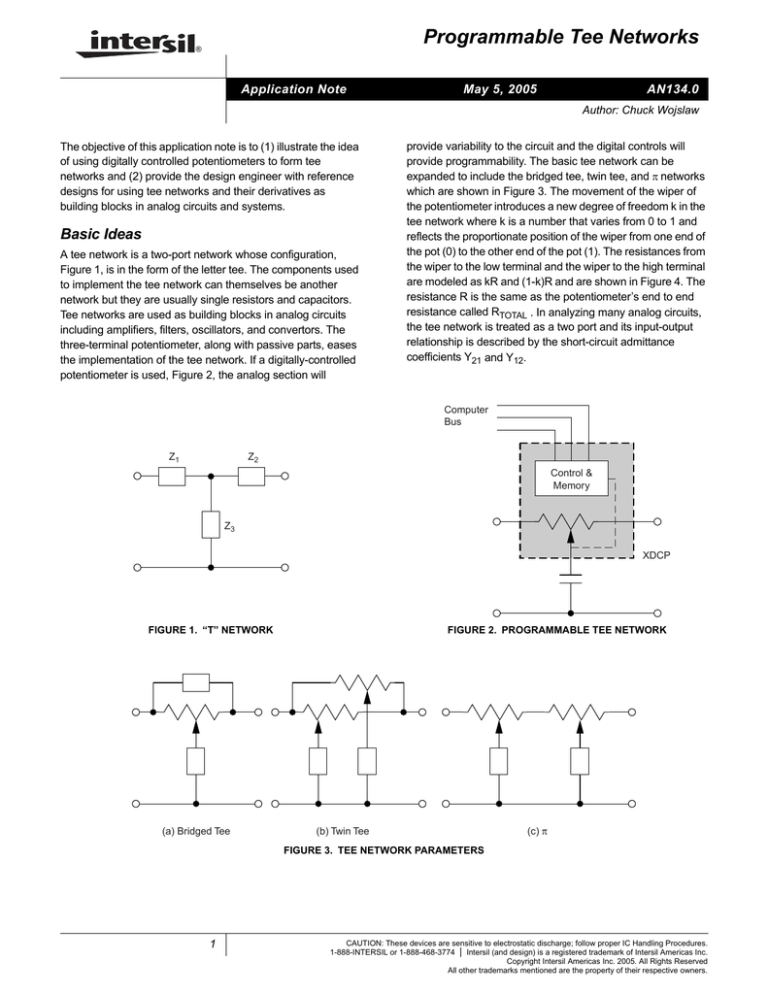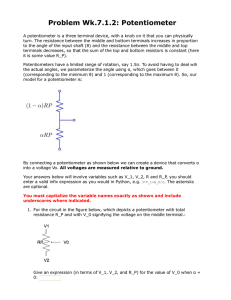
Programmable Tee Networks
®
Application Note
May 5, 2005
AN134.0
Author: Chuck Wojslaw
The objective of this application note is to (1) illustrate the idea
of using digitally controlled potentiometers to form tee
networks and (2) provide the design engineer with reference
designs for using tee networks and their derivatives as
building blocks in analog circuits and systems.
Basic Ideas
A tee network is a two-port network whose configuration,
Figure 1, is in the form of the letter tee. The components used
to implement the tee network can themselves be another
network but they are usually single resistors and capacitors.
Tee networks are used as building blocks in analog circuits
including amplifiers, filters, oscillators, and convertors. The
three-terminal potentiometer, along with passive parts, eases
the implementation of the tee network. If a digitally-controlled
potentiometer is used, Figure 2, the analog section will
provide variability to the circuit and the digital controls will
provide programmability. The basic tee network can be
expanded to include the bridged tee, twin tee, and π networks
which are shown in Figure 3. The movement of the wiper of
the potentiometer introduces a new degree of freedom k in the
tee network where k is a number that varies from 0 to 1 and
reflects the proportionate position of the wiper from one end of
the pot (0) to the other end of the pot (1). The resistances from
the wiper to the low terminal and the wiper to the high terminal
are modeled as kR and (1-k)R and are shown in Figure 4. The
resistance R is the same as the potentiometer’s end to end
resistance called RTOTAL . In analyzing many analog circuits,
the tee network is treated as a two port and its input-output
relationship is described by the short-circuit admittance
coefficients Y21 and Y12.
Computer
Bus
Z1
Z2
Control &
Memory
Z3
XDCP
FIGURE 2. PROGRAMMABLE TEE NETWORK
FIGURE 1. “T” NETWORK
(a) Bridged Tee
(b) Twin Tee
(c) π
FIGURE 3. TEE NETWORK PARAMETERS
1
CAUTION: These devices are sensitive to electrostatic discharge; follow proper IC Handling Procedures.
1-888-INTERSIL or 1-888-468-3774 | Intersil (and design) is a registered trademark of Intersil Americas Inc.
Copyright Intersil Americas Inc. 2005. All Rights Reserved
All other trademarks mentioned are the property of their respective owners.
Application Note 134
kR
(1-k)R
L
C
H
I2
I1
R2
R1
W
–
VS
V2
V1
Y21 =
V1
R
GO = – R2
1
0≤k≤1
R = RTOTAL
I2
V2 = 0
fC =
I1
V1 = 0
FIGURE 4. TEE NETWORK PARAMETERS
The use of digitally-controlled potentiometers in
programmable tee networks will be illustrated in several
representative circuits including amplifiers, filters, and
convertors.
AMPLIFIERS:
Digitally Controlled Potentiometer Sets Cutoff Frequency
FILTERS:
Programmable Tee Network
Controls Sallen and Key Filter
Programmable Tee Networks
Control IGSF Filter
CONVERTERS:
1
2πR2C
FIGURE 5. TRADITIONAL INVERTING AMPLIFIER
Y12 =
V2
VO
+
The circuit in Figure 6 is an inverting amplifier that uses the
digitally-controlled potentiometer and a fixed capacitor as an
input ‘tee’ network. The magnitude of the gain for this
inverting circuit is the same as the traditional circuit R2/R1
but the cutoff frequency is established by R1, capacitor C,
and the location of the wiper along the resistor array of the
potentiometer. Since the wiper of the digitally-controlled
potentiometer is digitally or computer controlled, the upper
cutoff frequency can then be programmed.
Network B
kR1
I to V Converter
These basic analog circuits are used as universal building
blocks in the design of analog systems and they also serve
as models for more specialized analog functions. The
following collection of independent articles and circuits are
examples of using programmable tee networks in analog
circuits. All of them have been breadboarded and tested.
R2
(1-k)R1
–
+
VS
VO
C
Network A
Digitally Controlled Potentiometer Sets
Cutoff Frequency
The traditional way of controlling the upper cutoff frequency
in the basic inverting amplifier circuit of Figure 5 is to parallel
R2 with a capacitor C. The cutoff frequency is controlled with
the capacitor C and the magnitude of the circuit gain is
independently established by R2 and R1 (=R2/R1). If we
need a variable cutoff frequency, we use a variable
capacitor. This approach has two major problems: (1) the
circuit does not lend itself to computer control and (2)
availability of variable capacitors, especially in the nF region.
2
FIGURE 6. AMPLIFIER WITH INPUT TEE NETWORK
The circuit gain (as a function of frequency) can be
determined using several analysis approaches. One
approach is to use Y or admittance parameters. If network A
and network B are treated as two-ports, the ratio of the shortcircuit admittance coefficient Y21 for the input port to Y12 for
the feedback port will produce the gain expression (Figure 6).
AN134.0
May 5, 2005
Application Note 134
frequency varies from infinite Hertz to a minimum frequency
and back to infinite Hertz. The minimum frequency is:
Y 21A
( R 2 ⁄ R 1 ) ( 1 ⁄ R 1 Ck ( 1 – k ) )
Vo
= --------------------------------------------------------------------------- = ------------Y 12B
Vs
jω + ( 1 ⁄ R 1 Ck ( 1 – k ) )
4
f c ( min ) = -----------------------( 2π )R 1 C
k is a number that varies from 0 to 1 and reflects the
proportionate position of the wiper from one end (0) of the
potentiometer to the other end (1).
For the Intersil digitally-controlled potentiometer (XDCP), k will
vary from 0 to 1 with a resolution determined by the number of
taps or programmable wiper positions and R1 represents the
RTOTAL of the potentiometer. The number of taps varies from 32
to 256 and RTOTAL varies from 1kΩ to 1MΩ depending on the
particular potentiometer. A wiper or cutoff frequency setting can
be stored in the XDCP’s nonvolatile memory permitting the
circuit’s cutoff frequency to return to a predetermined value on
power-up.
The circuit’s gain expression is of the form
Ao ωc
V
------o- = -----------------Vs
jω + ω c
which is that of an amplifier or low pass filter with a gain
G = - R2/R1 and a cutoff frequency.
1
f c = ---------------------------------------2πR 1 Ck ( 1 – k )
For the circuit values shown in Figure 7, the gain is -4.7 and the
cutoff frequency varies from 6.4kHz to the frequency limited by
the LT1007. The circuit uses Intersil’s X9C103 which is a 10kΩ
potentiometer with 100 taps and a three-wire interface. Other
XDCPs are available with SPI and I2C interfaces. The circuit
can be used in audio, control, and signal processing
applications. (Published in EDN, June 10, 1999.)
As the wiper is programmed from one end of the potentiometer
to the other, k varies from 0 to midscale (1/2) to 1, and the cutoff
X9C103
(10kΩ)
CS
INC
Controls
Cutoff
Frequency
R1
+5V
U/D
2
1
7
R2
8
47kΩ
Control &
Memor y
+5V
VS
3
6
2
7
–
+
4
3
6
VO
LT1097
–5V
C
.01µF
VO
G= V
S
5
4
AOωC
= jω + ω =
C
– (R 2 /R1) (1/R1Ck(1-k))
jω + (1/R1Ck(1-k))
Ao = - R2 /R1 = – 4.7
ω
fC = 2πC
=
1
2πR 1 Ck(1-k)
4
fC (min) = 2πR C
1
= 6.4 kHz
FIGURE 7. COMPUTER CONTROLLED AMPLIFIER
3
AN134.0
May 5, 2005
Application Note 134
Programmable Tee Network Controls
Sallen and Key Filter
This is the classic expression for a second order low pass
filter where
The circuit in Figure 8 is a common way of implementing a
second order, low pass filter. This Sallen and Key scheme
provides a passband gain A0 of one and R1, R2, C1, and C2
establish the characteristic frequency ω0 and figure of merit Q.
The circuit in Figure 9 replaces R1 and R2 with a digitallycontrolled potentiometer and along with C1 is configured as a
tee network. The location of the wiper changes the relative
values of R1 and R2 and thus introduces another degree of
freedom in the filter design. Since the wiper of the Intersil
digitally-controlled potentiometer (XDCP) is computer
controlled, this new degree of freedom k can be programmed.
k is a number that varies from 0 to 1 and reflects the
proportionate position of the wiper from one end (0) of the
potentiometer to the other end (1). The resolution of k is
determined by the number of taps or programmable wiper
positions and R represents RTOTAL or the end to end
resistance of the potentiometer. The gain expression or
transfer function for this circuit is:
A0 = 1 = Pass Band Gain
1
------------------------------------------2
x ( 1 – x )R C 1 C 2
Vo
------- = ----------------------------------------------------------------------------------------------------------------------2
2
s + s [ 1 ⁄ k ( 1 – k )RC 1 ] + 1 ⁄ k ( 1 – k )R C 1 C 2
Vs
A o ω o2
V
------o- = ------------------------------------------------2
Vs
2
s + s ( ωo ⁄ Q ) + ωo
ω0 =
1
-------------------------------------------- ,
2
k ( 1 – k )R C 1 C 2
and
Q =
k ( 1 – k )C
---------------------------1C2
The accuracy of filter parameters is dependent on the
component sensitivities and the tolerance of the component
values. Precise values of the parameters are difficult to achieve
because precise values of capacitance are limited and
expensive. This limitation of performance can be overcome
using the programmable tee network. The characteristic
frequency ω0 or figure of merit Q can be precisely controlled
depending on the critical need of the application.
For the values shown in Figure 9, the filter can be programmed
for a theoretical maximally flat magnitude (MFM or Butterworth)
response when k = 13/63. For this value of k, Q = .704 and
f0 = 6.85kHz. When the programmable tee network is at its
limits (k = 0 or k = 1), the circuit reduces to a first order low pass
filter whose cutoff frequency fc = 1/2πRC2. A second
potentiometer can be used to control the noninverting, closedloop gain of A1 and establish the passband gain A0 of the filter.
The electronic potentiometer adds variability to the filter circuit
and its digital controls, though its computer-controlled serial
bus, provide programmability. The X9418 has a 2-wire (I2C
like) serial bus. An automated closed-loop calibration
procedure to program the filter saves test time and provides
enhanced performance and security. (to be published in
Electronics World [UK])
4
AN134.0
May 5, 2005
Application Note 134
R1
R2
+
VS
VO
C1
V
T(s) = VO =
S
–
C2
1
R1R2C1C2
s2 +
( R 1C
+
2 1
=
1
1
+
R2C2
R1C1
) s + R R 1C C
1 2 1 2
GO ωO2
s2 + (ωO/Q)s + ωO2
FIGURE 8. MODEL OF SALLEN AND KEY FILTER
CLK
SDA
1/2 X9418
ADDR
VO
VS =
Control &
Memory
+5V
VS
C2
.0033
+
LT1097
–
–5V
kR
(1-k)R
1
k(1-k)R2C1C2
s2 + s [1/k(1-k) RC1 ] + 1/k(1-k) R2C1C2
AO = GO = –1
A1
VO
ωO =
1
k(1-k)R2C1C2
Q=
k(1-k)C1
C2
MFM (Marginally Flat Magnitude)
k = 13/63
Q = .704
fO = fC = 6.85kHz
C1
.01
FIGURE 9. SALLEN AND KEY FILTER WITH THE TEE NETWORK
5
AN134.0
May 5, 2005
Application Note 134
Programmable Tee Networks Control
IGSF Filter
The circuit in Figure 10 is a second order, low pass filter
model that falls in the Infinite Gain, Single Feedback (IGSF)
class. IGSF type filters are characterized by two-port input
and feedback networks. Common two-ports used in filters
are the tee network and its bridged tee and twin tee
derivatives. If a digitally controlled potentiometer and a
capacitor are used to implement the tee network, variability
and programmability are added to the circuit.
The circuit in Figure 11 is basically an inverting amplifier
where the input circuit A is a tee network and the feedback
circuit B is a bridged tee network. The movement of the
wiper of the potentiometer introduces a new degree of
freedom k in the filter design where k is a number that varies
from 0 to 1 and reflects the proportionate position of the
wiper from one end of the pot (0) to the other end of the pot
(1). The gain expression or transfer function of the filter is
found by finding the ratio of the short-circuit admittance
coefficients of the input and feedback networks. For this
circuit,
Y 21A
1 ⁄ kR ( 1 – k )RC 1 C 2
V0
------- = – ------------= – ---------------------------------------------------------------------------------------------------------------------------2
2
Vs
Y 12B
s + s [ ( 1 ⁄ k ( 1 – k )RC 1 ] + 1 ⁄ k ( 1 – k )R C 1 C 2
This is the classic expression for a second order filter given
by
A o ω o2
Vo
------- = ------------------------------------------------2
Vs
2
s + s ( ωo ⁄ Q ) + ωo
where AO, ωO, and Q represent the passband gain,
characteristic frequency, and figure of merit respectively.
From the gain expression,
A0 = 1,
ωo =
1
-------------------------------------------- ,
2
k ( 1 – k )R C 1 C 2
and
Q =
k ( 1 – k )C
---------------------------1C2
The movement of the wiper described by k(1-k) in the
expressions for ω0 and Q is parabolic. Depending on the
application, the digitally controlled potentiometers can be
programmed to optimize the characteristic frequency ω0 or
the quality factor Q. The accuracy of filter parameters is
dependent on the component sensitivities and the tolerances
of the component values. Precise values of the parameters
are difficult to achieve because precise values of
capacitance are limited and expensive. This limitation in
performance can be overcome using the programmable tee
network. The X9418 is dual potentiometer device with a
2-wire (I2C) interface and the ganging of the potentiometer
wipers is done through the software.
For the circuit values shown in Figure 11, the filter can be
programmed for a theoretical maximally flat magnitude
(MFM or Butterworth) response when k=13/63. For this
value of k, Q=0.704 and fc = 6.85kHz. The measured
response for this setting is shown in Figure 12. When the
programmable tee network is at its limits (k=0 or k=1), the
circuit reduces to a first order low pass RC filter whose cutoff
frequency is determined by the 10kΩ resistance of the
potentiometer and C2.
The electronic potentiometer adds variability to the filter circuit
and its digital controls, through its computer-controlled serial
bus, provides programmability. An automated closed-loop
calibration procedure to program or calibrate the filter saves
test time and provides enhanced performance and security.
(Published in Electronic Design, October 4, 1999.)
6
AN134.0
May 5, 2005
Application Note 134
Network B
Network A
–
VS
VO
+
T(s)
VO
=
=–
VS
Y21A
Y12B
FIGURE 10. MODEL OF IGSF FILTER
CLK
SDA
ADDR
C2
+5V
.0033
10kΩ
Network B
X9418W
Control &
Memory
Control
Cutoff
Frequency
and Q
C1
.01
kR (1-k)R
+5V
VS
–
10kΩ
VO
+
Network A
–5V
–5V
VO
VS
C1
A1
.01
L T1097
Y
= - Y21A
=
12B
A O = –1
ωO
=
–1/kR(1-k)RC1 C 2
s 2 +s[1/k(1-k)RC1 ]+1/k(1-k)R 2 C1C 2
1
2
k(1-k)R C1 C 2
Q=
k(1-k)C 1
C2
MFM RESPONSE: k = 13/63, Q = .704, f C = 6.85kHz
FIGURE 11. IGSF FILTER WITH TEE NETWORKS
7
AN134.0
May 5, 2005
Application Note 134
|Vo|Vs|
-0
-2
-4
dB
-6
-8
-10
-12
-14
-16
-18
20
50
100
200
500
1k
2k
5k
10k
Hz
20k
logf
FIGURE 12. MFM RESPONSE OF IGSF FILTER
I to V Convertor
The circuit in Figure 13 is an input current (I) to output
voltage (V) convertor. The feedback portion of the circuit is a
tee network of resistive elements consisting of a digitally
controlled potentiometer and a fixed resistor R1(=R). The
input–output relationship for the I to V convertor is
Tee Network
+5V
INC
U/D
(1 + k – k2)
V0
----------------------------------- = – R
k
Is
(1-k)R
X9C102 (1kΩ)
CS
H
Control
&
Memory
kR
W
+5V
L
R (1kΩ)
–
where k is a number that varies from 0 to 1 and reflects the
proportionate position of the wiper from one end (0) of the
potentiometer to the other end (1). The programming of the
location of the wiper changes the scale factor between the
input current and output voltage without changing the values
of any of the resistances and avoids the use of high value
resistors in measuring low values of current. As k goes from 1
to 0, the scale factor goes from –R (1) to a theoretical –R(∝).
The high impedance output of many transducers, like
photodiodes and photovoltaic cells, is modeled as a current
source.
8
VO
+
IS
–5V
LT1097
1 + k - k2
VO
= –R
k
IS
1µA < IS < 1mA
FIGURE 13. I TO V CONVERTOR
AN134.0
May 5, 2005
Application Note 134
The programming of the 100 tap potentiometer provides for
a two-decade change in effective resistance thus allowing
the circuit to measure at least three decades of current. For
the values shown, the circuit can measure current from 1µA
to 1mA.
If we connect the tee network as shown shown in Figure 14, the
expression for the scale factor changes to a parabolic-like
expression given as -R(1+k-k2). This network can also be
used in the traditional inverting amplifier circuit, Figure 15, to
provide a variable gain described by
(1-k)R
2
Vo
R(1 + k – k )
---------------------------------------= –
R1
Vs
As k goes from 1 to 0, the magnitude of the gain goes from
R/R1 to 1.25 (R/R1) to R/R1 thus providing for a 25%
variation in the circuit’s voltage gain.Tee-like Network:
kR
(1-k)R
R
kR
R
R1
–
VO
+
IS
VO
IS
= –R (1 + k - k2)
FIGURE 14. I TO V CONVERTOR (VERSION 2)
–
VS
VO
+
VO
VS
= –
R (1 + k - k2)
R1
FIGURE 15. AMPLIFIER WITH VARIABLE GAIN
Intersil Corporation reserves the right to make changes in circuit design, software and/or specifications at any time without notice. Accordingly, the reader is cautioned to
verify that the Application Note or Technical Brief is current before proceeding.
For information regarding Intersil Corporation and its products, see www.intersil.com
9
AN134.0
May 5, 2005




